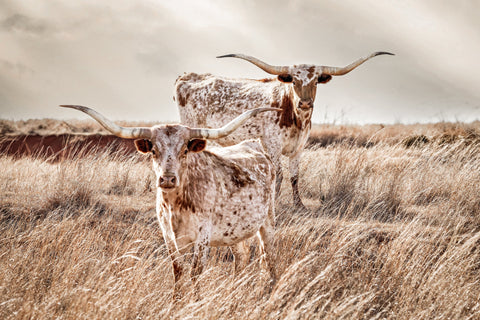Share
The Legacy of the Texas Longhorn: A Journey Through Time
The Texas Longhorn, an iconic symbol of the American West, embodies the rugged individualism and enduring spirit of the region's history. Known for their distinctive long, curved horns and diverse color patterns, Texas Longhorns have a storied past that mirrors the tumultuous and vibrant history of the United States itself. This blog post delves into the rich history of the Texas Longhorn cattle, tracing their journey from prehistoric ancestors to their pivotal role in American history and culture.
Pre-Columbian Origins
The history of Texas Longhorn cattle begins long before European settlers set foot on American soil. Their ancestors were brought to the New World by Spanish explorers and colonists in the late 1400s and early 1500s. These cattle, primarily of Andalusian, Barrenda, and Retinto breeds, adapted quickly to the diverse ecosystems they encountered. They roamed freely and multiplied in what is now Mexico, the Southwest, and eventually, Texas.
Longhorn Survival and Adaptation
As the descendants of these Spanish cattle roamed untamed, they evolved over several centuries into a unique breed, perfectly adapted to the harsh conditions of the North American wilderness. The Texas Longhorn's ability to survive on sparse vegetation, resist diseases, and navigate vast and varied landscapes made them invaluable to the indigenous peoples and early settlers of the region. Their long horns, which could span up to seven feet, served as formidable tools for defense against predators.
Cattle Drives and Cowboys
By the mid-19th century, the Texas Longhorn had become central to the burgeoning cattle industry, driven by the demand for beef in the growing cities of the Northeast and Midwest. The era of cattle drives began, with cowboys herding vast numbers of Longhorns along trails such as the Chisholm and Goodnight-Loving, from Texas to railheads north. These drives were fraught with dangers but they played a crucial role in the expansion of the American frontier.
Decline and Preservation
The advent of barbed wire in the late 19th century, along with competition from other cattle breeds and the near-collapse of the open range, led to a sharp decline in the Texas Longhorn population. By the early 20th century, they were on the brink of extinction. However, thanks to the efforts of conservationists and ranchers who recognized the historical and genetic value of the Texas Longhorn, initiatives were launched to preserve the breed. The establishment of federal and state preserves, as well as private herds, helped to slowly rebuild the population.
Longhorn Legacy and Revival
Today, the Texas Longhorn is celebrated not only for its contribution to American history but also for its unique genetic traits, including lean meat, hardiness, and fertility. They are a fixture at rodeos, parades, and as mascots for schools and sports teams, embodying the enduring spirit of the West.
The Texas Longhorn's history from the Spanish conquests to the cattle drives, near extinction, and subsequent revival, is a testament to their resilience and adaptability. They are not merely cattle but a symbol of American heritage, representing the unbridled spirit of a nation and its continuous evolution. As we look back on the history of the Texas Longhorn, we are reminded of the intricate tapestry of events and influences that shape our world, underscoring the importance of preservation and respect for the natural and cultural legacies we inherit.


